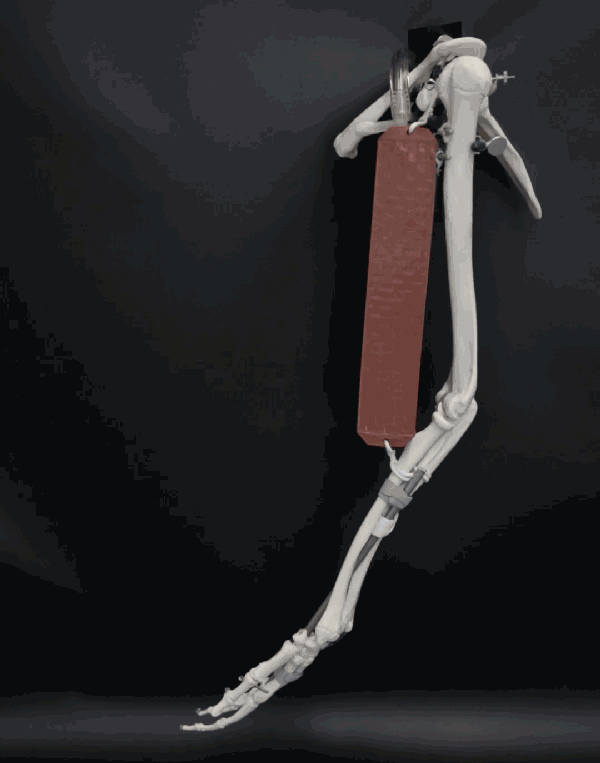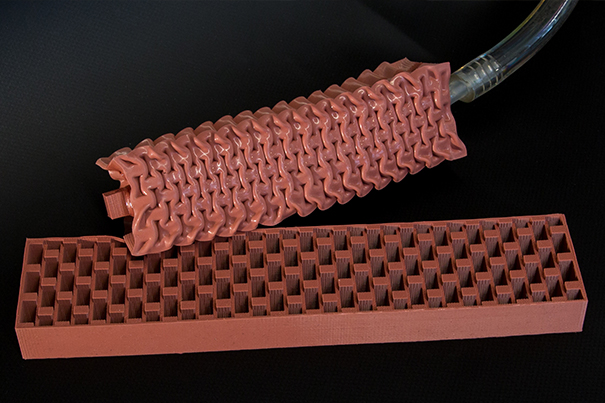Soft, safe robot actuators inspired by human bicep muscles
June 2, 2016

VAMPs are functionally modeled after the human bicep, similar to the biological muscle in terms of response time and efficiency. (credit: Wyss Institute at Harvard University)
If robots are going work around humans, they will have to be softer and safer. A Harvard team has designed a new actuator with that in mind. Its movements are similar to those of a human bicep muscle, using vacuum power to automate soft rubber beams. Like real muscles, the actuators are soft, shock-absorbing, and pose no danger, according to the researchers.
The work is led by George Whitesides, Ph.D., a Core Faculty member at Harvard’s Wyss Institute for Biologically Inspired Engineering, the Woodford L. and Ann A. Flowers University Professor of Chemistry and Chemical Biology in Harvard University’s Faculty of Arts and Sciences (FAS), and a Director of the Kavli Institute for Bionano Science and Technology at Harvard University.
Whitesides’ team took an unconventional approach to its design, relying on vacuum to decrease the actuator’s volume and cause it to buckle. While conventional engineering would consider bucking to be a mechanical instability and a point of failure, in this case the team leveraged this instability to develop VAMPs (vacuum-actuated muscle-inspired pneumatic structures). Previous soft actuators rely on pressurized systems that expand in volume, but VAMPs mimic true muscle because they contract, which makes them useful in confined spaces and for a variety of purposes.

In this image, VAMPs are shown actuated and cut open in cross section. The honeycomb cross section shows the inner chambers that collapse when vacuum is applied. (credit: Wyss Institute at Harvard University)
The actuator has soft elastomeric rubber beams filled with small, hollow chambers of air like a honeycomb. By applying vacuum, the chambers collapse and the entire actuator contracts, generating movement. The internal honeycomb structure can be custom tailored to enable linear, twisting, bending, or combinatorial motions.
The team envisions that robots built with VAMPs could be used to assist the disabled or elderly, to serve food, deliver goods, and perform other tasks related to the service industry. Soft robots could also make industrial production lines safer and faster, and quality control easier to manage by enabling human operators to work in the same space.
Fail-safe design
VAMPs are designed to prevent failure — even when damaged with a 2mm hole, the team showed that VAMPs will still function. In the event that major damage is caused to the system, it fails safely. “It can’t explode, so it’s intrinsically safe,” said Whitesides. Whereas other actuators powered by electricity or combustion could cause damage to humans or their surroundings, loss of vacuum pressure in VAMPs would simply render the actuator motionless.
“These self-healing, bioinspired actuators bring us another step closer to being able to build entirely soft-bodied robots, which may help to bridge the gap between humans and robots and open entirely new application areas in medicine and beyond,” said Wyss Founding Director Donald Ingber, M.D., Ph.D., who is also the Judah Folkman Professor of Vascular Biology at Harvard Medical School and the Boston Children’s Hospital Vascular Biology Program, as well as Professor of Bioengineering at Harvard’s John A. Paulson School of Engineering and Applied Sciences (SEAS).
The work was reported June 1 in the journal Advanced Materials Technologies.
Harvard’s Office of Technology Development has filed patents on this and related inventions, and the soft actuator technology has been licensed to Soft Robotics, Inc., a startup launched in 2013 and cofounded by Whitesides. The company is developing robotic grasping systems toward initial applications including picking and packing in unstructured environments — for example, handling fruits and vegetables in produce distribution warehouses. Longer term, this technology can be leveraged to develop products for biomedical applications.
Abstract of Buckling Pneumatic Linear Actuators Inspired by Muscle
The mechanical features of biological muscles are difficult to reproduce completely in synthetic systems. A new class of soft pneumatic structures (vacuum-actuated muscle-inspired pneumatic structures) is described that combines actuation by negative pressure (vacuum), with cooperative buckling of beams fabricated in a slab of elastomer, to achieve motion and demonstrate many features that are similar to that of mammalian muscle.